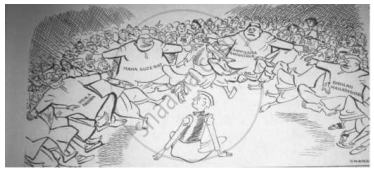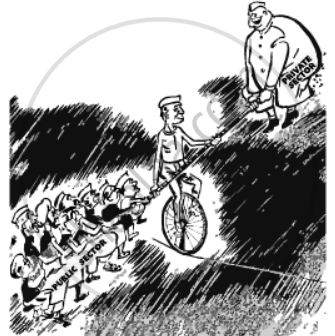Advertisements
Advertisements
प्रश्न
What were the major differences in the approach towards development at the time of Independence? Has the debate been resolved?
उत्तर
At the time of independence, development was about becoming more like the industrialised countries of the West, to be involved with the break down of traditional social structure as well as rise of capitalism and liberalism.
1. Modernisation referred to growth, material progress and scientific rationality.
2. India had two models of modern development at the time of independence into considerations to be adopted i.e. the liberal capitalist model like Europe and the US and the socialist model like the USSR.
3. A debate had been occurred regarding adoption of model of development as communists, socialists and Pt. J.L. Nehru supported the socialist model to reflect a broad consensus to be developed during national movement.
4. Above mentioned intentions cleared that the government made the priority to poverty alleviation alongwith social and economic redistribution.
5. At the same time, these leaders differed and debated:
- Industrialisation should be the preferred path or
- Agricultural development should take place or
- Rural poverty should be alleviated.
APPEARS IN
संबंधित प्रश्न
Match the following :
| (a) Charan Singh | (i) Industrialization |
| (b) PC Mahalanobis | (ii) Zoning |
| (c) Bihar Famine | (iii) farmers |
| (d) Verghese Kurien | (iv) Milk Cooperatives |
“Indian policy makers made a mistake by emphasising the role of state in the economy. India could have developed much better if private sector was allowed a free play right from the beginning”. Give arguments for or against this proposition.
Tribals of Odisha fear their displacement due to the extraction of which mineral?
In India, planning was conceived as the main instrument of ______.
The Chairman of the National Development Council is ______.
Planning Commission was scrapped on ______.
Who amongst the following is the longest serving member of Tripura State Planning Board?
Which state was carved out of Assam from the following?
______ Policy has been adopted by NITI Aayog.
Consider these statements about NITI Aayog. Find the Wrong statement.
Why was the Planning Commission replaced by NITI Aayog?
During the Nehru era, why did some political parties and groups in our country believe that India should be more friendly with the bloc led by the US?
Study the picture given below and answer the question that follows:

Choose the first state to be created due to linguistic demands after independence:
Observe the figure below and answer accordingly.

Who in the picture is balancing between the public and private sectors?
Read the following paragraph and answer according.
NITI Aayog or National Institution for Transforming India Aayog is basically a policy think tank of Government of India and State Governments that replaces the 65-year old Planning Commission.
The Union Government of India had announced formation of NITI Aayog on 1st January, 2015. The body is composed of a CEO and a Vice Chairperson, to be appointed by the Prime Minister, in addition to some full-time members and two part-time members, while four Union Ministers would serve as ex-officio members.
Besides, there would be specific regional councils, while experts and specialists from various fields would be called as special invitees nominated by the Prime Ministers.
NITI Aayog will serve as a “think tank” of the government as a “directional and policy dynamo” and would provide both to the governments at the centre and in the states with strategic and technical advice on key policy matters including economic issues of national and international importance.
NITI Aayog will have regional councils to focus on developmental activities on specific areas and is patterned on the National Reforms Development Commission of China.
The CFO and Vice Chairperson of NITI Aayog is appointed by ______.
Which of these statements about the Bombay Plan is incorrect?
Following are a few points given on the approach towards development at the time of Independence. Which of them is correct?
- The common perception of Development was becoming modernized which involved the breakdown of traditional social structure
- After independence India had two models of development one was Europe's and US's liberal capital model and the other USSR's socialist model.
- Many including the Communist Party of India and leaders like Nehru. were impressed by the Soviet model and very few favored the American models.
"GRAND INNOVATION CHALLENGE" was launched by
Read the following passage and answer the question.
"In the early years of Independence, two contradictory tendencies were already well advanced inside the Congress Party. On the one hand, the national party executive endorsed socialist principles of state ownership, regulation, and control over key sectors of the economy in order to improve productivity and at the same time curb economic concentration. On the other hand, the national Congress ·government pursued liberal economic policies and incentives to private investment that was justified in terms of the sold criterion of achieving a maximum increase in production". - Francine Frankel
What is the contradiction that the author is talking about? What would be the political implications of a contradiction like this?
What is the meaning and importance of economic planning in the Indian context?
In which year was the NITI Aayog constituted?
Choose the correct statement.
- The Club of Rome published a book in 1972 entitled Limits to Growth.
- In 1987, Brundtland Report, our common futures was published.
- The Rio Summit produced conventions dealing with climate change, and biodiversity forestry and recommended a list of development called Agenda 21.
- Common but differentiated responsibilities were declared at the Earth Summit in 1992.
Which of the following statements about NITI Aayog are true?
- NITI Aayog acts as a think tank of the Union Government.
- NITI Aayog acts against terrorism.
- NITI Aayog acts in a spirit of cooperative federalism.
- NITI Aayog design strategic and long term policy and programme frameworks.
Planning Commission was set up by ______.
Which one of the following is not the objective of NITI Aayog?
